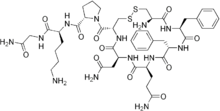Felypressin
Felypressin is a non-catecholamine vasoconstrictor that is chemically related to vasopressin, the posterior pituitary hormone. It is added to some local anaesthetics such as prilocaine in a concentration of 0.03 IU/ml. Felypressin is a Vasopressin 1 agonist, and will thus have effects at all Arginine vasopressin receptor 1As. It will, however, have its main physiological effects on vascular SMC's due to the form in which it is administered.
 | |
| Names | |
|---|---|
| IUPAC name
1-[19-Amino-13,16-dibenzyl-10-(2-carbamoyl-ethyl)-7-carbamoylmethyl-6,9,12,15,18-pentaoxo-1,2-dithia-5,8,11,14,17-pentaaza-cycloeicosane-4-carbonyl]-pyrrolidine-2-carboxylic acid [5-amino-1-(carbamoylmethyl-carbamoyl)-pentyl]-amide | |
| Identifiers | |
CAS Number |
|
3D model (JSmol) |
|
| ChEBI | |
| ChEMBL | |
| ChemSpider | |
| DrugBank | |
| ECHA InfoCard | 100.000.257 |
PubChem CID |
|
| UNII | |
InChI
| |
SMILES
| |
| Properties | |
Chemical formula |
C46H65N13O11S2 |
| Molar mass | 1040.22 g/mol |
Except where otherwise noted, data are given for materials in their standard state (at 25 °C [77 °F], 100 kPa). | |
| Infobox references | |
V1 receptors are found in various sites around the body. The major points include the CNS, Liver, Anterior Pituitary, Muscle (both vascular and non-vascular smooth muscle), and Platelets (CLAMP).
Another example of a V1 agonist is terlipressin - which is used in oesophageal varices.
References
- "Vasopressin analogues and treatments", Prof Buckingham, Imperial College School of Medicine (ICSM) - adapted by JHPatel
This article is issued from
Wikipedia.
The text is licensed under Creative
Commons - Attribution - Sharealike.
Additional terms may apply for the media files.